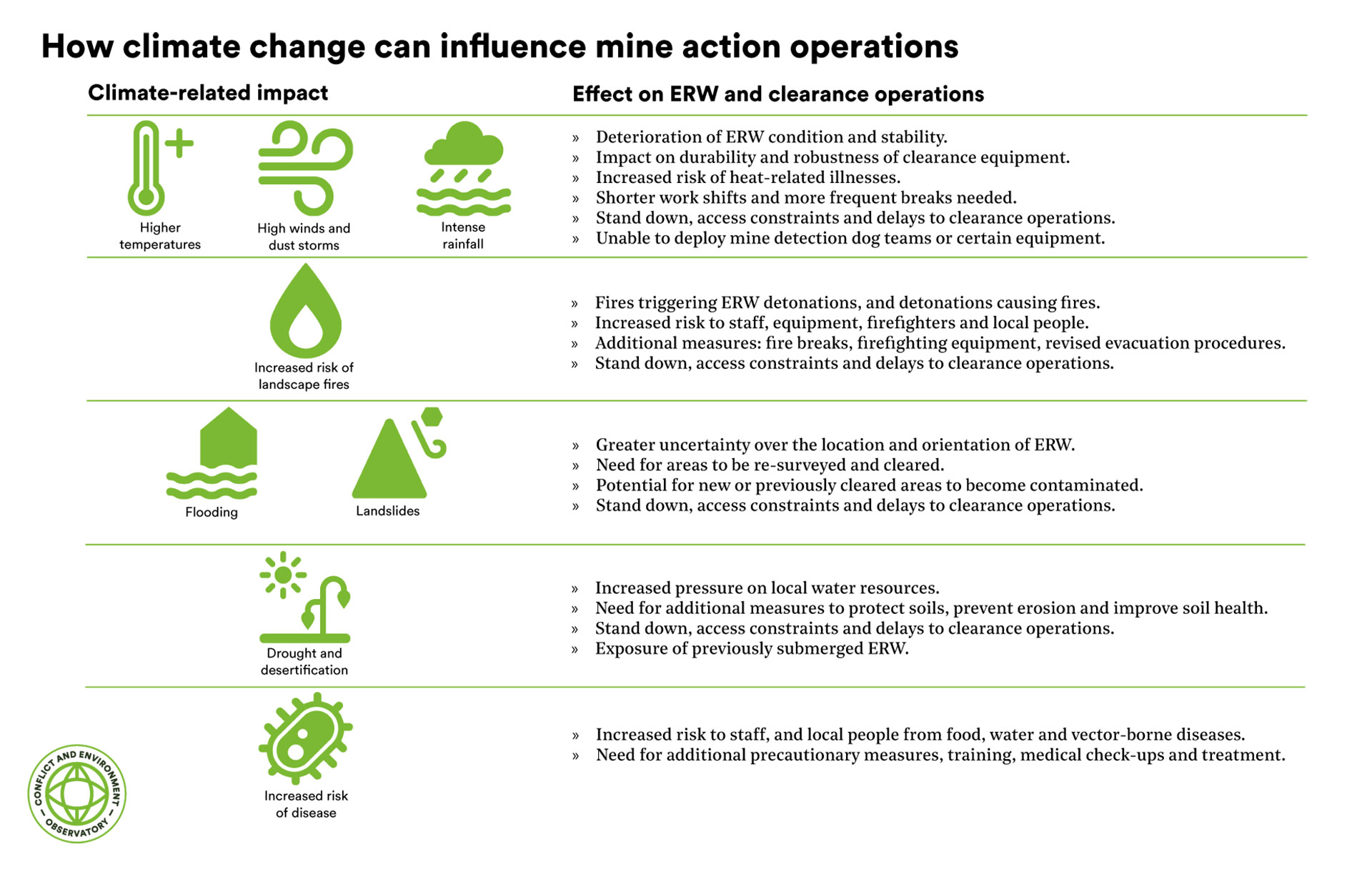Landmines, climate change and new environmental guidance
Climate change is already affecting areas contaminated by landmines and other explosive remnants of war. Linsey Cottrell explains the key issues, and how the mine action sector should prepare and adopt the environmental guidance in the newly updated International Mine Action Standard IMAS 07.13.
A global threat
Wars damage the environment in many ways. Landmines and other explosive remnants of war (ERW) can remain in the ground for decades after conflicts end. Not only do they present a threat to people and ecosystems while in place, clearing ERW can also adversely impact the environment if not properly managed. This can be due to cratering, soil erosion, vegetation removal or localised pollution.
They are a global threat. Even before Russia's invasion of Ukraine an estimated 60 million people lived in areas affected by ERW contamination. For example, Afghanistan, Cambodia, Iraq and South Korea are all classed as massively contaminated by anti-personnel mines. In some cases, the full extent of contamination remains unknown. In 2023, Ukraine estimated that approximately 174,000 km2 of its territory needed to be surveyed for contamination, and is now considered to be among the most mined countries in the world. The extent of contamination in Azerbaijan,1 Morocco and Myanmar is also unknown, but likely to be massive. For cluster munitions,2 there are no reliable estimates for Vietnam and Lao PDR, but more than 1,000 km2 are believed to be contaminated.
What is the relationship between climate change, landmines and other explosive remnants of war?
Conflict-affected countries are among the most vulnerable to the effects of climate change. Climate finance to support fragile and conflict-affected states is grossly inadequate and, in an example of climate injustice, without significant changes in access to climate funds, these communities will become more vulnerable and less able to cope.
Climate change can impact areas affected by ERW contamination in several ways. Extreme weather events such as flooding and heatwaves can increase the risks posed by ERW contamination; remobilising ERW or triggering landscape fires. ERW clearance and removal operations will need to adapt to meet the challenges of climate change, while local communities may need assistance and support to build climate resilience. Examples of how climate change can directly affect ERW contamination and clearance operations are given in the table below. In each case, people living in communities affected by contamination will also be exposed to these climate risks, and the compounding impacts of other socio-economic factors and environmental degradation.

New environmental and climate guidance is available for the sector
The International Mine Action Standards provide standards and guidance to enable safe and effective implementation of all mine action activities, including the clearance of mines and release of land back to communities, risk education, victim assistance and stockpile destruction.
In July 2024, the updated IMAS 07.13 on environmental management and climate change was published. This important update reflects the need to incorporate climate change and adaptation needs, and was developed by a Technical Working Group (TWG) led by Norwegian People's Aid with support from CEOBS and others. CEOBS and Norwegian People's Aid have collaborated closely on environmental mainstreaming across the mine action sector since 2018, and the updated guidance reflects many of the policies we have explored.
As well as incorporating climate change, the new IMAS 07.13 also sets out the need to better understand the environmental setting of clearance activities and its sensitivity. This baseline information - such as whether people live nearby, if the area is ecologically important, or if the area is particularly vulnerable to climate change - is essential for making informed decisions, predicting potential impacts, and designing effective mitigation, management or adaptation strategies.
The TWG also included the US Office of Weapons Removal and Abatement (PM/WRA), which is significant since the US remains the largest single donor to mine action.3 Donor support for the revised standard is critical, and it is hoped this can encourage funding to embed climate adaptation measures, which could benefit local communities and support nature protection and recovery.
Finally, the new standard highlights the need for mitigation measures to reduce the greenhouse gas emissions and carbon footprint of mine action organisations. This aligns with initiatives such as the Climate and Environment Charter for Humanitarian Organisations, which features commitments to reduce the environmental impact of humanitarian activities, build resilience, and increase focus on the adoption of Nature-based Solutions.
The need for sectoral action on climate and environment
Climate change not only complicates mine action activities, it also impacts local communities, places pressure on local resources and land, and may force people to move and resettle. The new IMAS 07.13 specifically highlights the need to be 'open to opportunities for embedding climate adaptation and environmental initiatives which could benefit local communities.' This means there will be a need to collect the right environmental data, at an appropriate level of detail, to support decision-making and to communicate outcomes to stakeholders.
Donors are acknowledging the wider benefits that mine action can achieve. The new Mine Action Strategy 2024-2028 from the German Federal Foreign Office states that 'partner organisations are encouraged to enter into cooperation arrangements with relevant partners in order to facilitate nature restoration following successful land surveys and ERW clearance, and to foster the sustainable and ecologically valuable use of released land'.
This is encouraging and we now need to see the prioritisation of projects, and the flexible funding that can deliver these multiple benefits to conflict-affected communities.
- Contamination in Azerbaijan is unknown, but certainly massive given the 254 km long and 5 km wide former line of contact between Armenian and Azeri armed forces.
- A cluster munition has a container that disperses 'bomblets' that can be deployed by rockets or air-dropped bombs. They are used to kill people or destroy vehicles (or both).
- See table: Contributions by donors: 2018-2022, p88 in the Landmine Monitor, 2023 report.